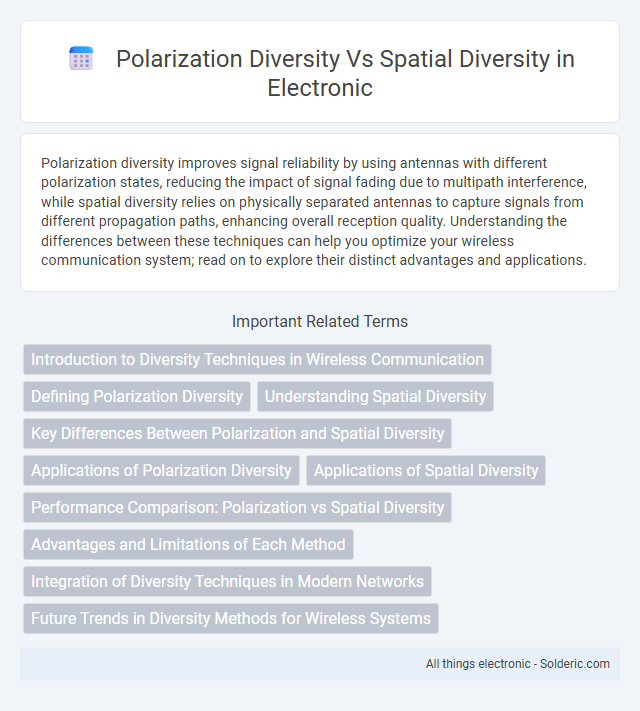Polarization diversity improves signal reliability by using antennas with different polarization states, reducing the impact of signal fading due to multipath interference, while spatial diversity relies on physically separated antennas to capture signals from different propagation paths, enhancing overall reception quality. Understanding the differences between these techniques can help you optimize your wireless communication system; read on to explore their distinct advantages and applications.
Comparison Table
| Aspect | Polarization Diversity | Spatial Diversity |
|---|---|---|
| Definition | Utilizes multiple antenna polarizations (e.g., vertical and horizontal) to improve signal quality. | Employs physically separated antennas to combat multipath fading and signal degradation. |
| Main Benefit | Reduces polarization fading and improves signal reliability. | Mitigates multipath fading by leveraging spatially uncorrelated paths. |
| Implementation Complexity | Lower complexity; uses co-located antennas with different polarizations. | Higher complexity; requires physical antenna separation and infrastructure. |
| Typical Use Case | Compact devices needing antenna diversity without extra space. | Base stations and outdoor environments with larger antenna arrays. |
| Effective in | Polarization-sensitive fading environments. | Multipath-rich environments with significant spatial decorrelation. |
| Hardware Requirements | Dual-polarized antennas or polarization switches. | Multiple physically spaced antennas, often several wavelengths apart. |
| Performance Improvement | Moderate improvement in signal-to-noise ratio (SNR). | Significant improvement in link reliability and diversity gain. |
Introduction to Diversity Techniques in Wireless Communication
Polarization diversity utilizes orthogonal polarization states of antennas to mitigate multipath fading, enhancing signal reliability without requiring additional spatial resources. Spatial diversity employs multiple antennas separated by physical distance to capture uncorrelated signal paths, improving reception quality and reducing the probability of deep fades. Both techniques serve as fundamental diversity strategies in wireless communication systems to increase robustness and maintain consistent signal quality in challenging propagation environments.
Defining Polarization Diversity
Polarization diversity refers to the use of antennas with different polarization orientations, such as vertical and horizontal, to improve signal quality and reduce fading in wireless communication systems. Unlike spatial diversity, which relies on physically separated antennas to capture uncorrelated signal paths, polarization diversity exploits the electromagnetic wave's polarization properties without requiring additional space. Your communication system can benefit from polarization diversity by enhancing signal reliability and mitigating interference in compact or space-constrained environments.
Understanding Spatial Diversity
Spatial diversity leverages multiple antennas separated by physical distances to mitigate signal fading and improve wireless communication reliability. It exploits the different signal paths and varying environmental conditions experienced by each antenna to enhance signal quality. This technique is particularly effective in environments with multipath propagation, where signals arrive via distinct paths causing independent fading.
Key Differences Between Polarization and Spatial Diversity
Polarization diversity utilizes different electromagnetic wave polarizations, such as vertical and horizontal, to reduce signal fading and improve wireless communication reliability. Spatial diversity relies on physically separated antennas to capture uncorrelated signal paths, enhancing signal quality through multipath propagation. Your choice between polarization and spatial diversity depends on factors like antenna placement constraints and environmental conditions affecting signal propagation.
Applications of Polarization Diversity
Polarization diversity enhances wireless communication reliability by using multiple polarization states to mitigate signal fading and interference, making it ideal for urban environments with complex signal reflections. Your network performance benefits in applications like satellite communication, MIMO systems, and radar, where maintaining signal integrity through varying polarization improves data throughput and reduces outages. Unlike spatial diversity, which relies on physical antenna separation, polarization diversity requires fewer spatial resources, offering efficient solutions in space-constrained settings.
Applications of Spatial Diversity
Spatial diversity enhances wireless communication reliability by using multiple antennas separated by physical distance to combat signal fading and interference. It is widely applied in cellular networks, MIMO systems, and Wi-Fi technologies to improve signal strength and increase data throughput. Your device benefits from spatial diversity through higher connection stability and better performance in challenging environments.
Performance Comparison: Polarization vs Spatial Diversity
Polarization diversity enhances signal performance by utilizing orthogonal polarizations to mitigate fading and improve link reliability, especially in environments with multipath interference. Spatial diversity achieves performance gains through physically separated antennas, effectively reducing signal correlation and combating shadowing and deep fades. Your system's performance depends on whether polarization diversity's compact, antenna-efficient approach or spatial diversity's greater physical separation better suits the propagation environment and deployment constraints.
Advantages and Limitations of Each Method
Polarization diversity enhances signal reliability by using orthogonal polarizations, effectively mitigating multipath fading and reducing interference in wireless communication systems; however, its effectiveness decreases in environments with depolarizing objects or heavy scattering. Spatial diversity relies on multiple antennas separated by a distance to provide independent fading paths, improving signal quality and coverage, but requires larger physical space and increased hardware complexity. Each method balances trade-offs between implementation complexity, environmental suitability, and performance gains, with polarization diversity offering compact solutions and spatial diversity providing robust mitigation in challenging propagation scenarios.
Integration of Diversity Techniques in Modern Networks
Polarization diversity and spatial diversity are crucial techniques integrated into modern wireless networks to enhance signal reliability and reduce fading. Polarization diversity exploits the orthogonal properties of electromagnetic waves to mitigate multipath interference, while spatial diversity uses multiple antennas at different locations to capture varied signal paths. Combining these diversity schemes in advanced MIMO systems significantly improves network capacity and robustness against signal degradation in urban and high-density environments.
Future Trends in Diversity Methods for Wireless Systems
Future trends in diversity methods for wireless systems emphasize the integration of polarization diversity with spatial diversity techniques to maximize channel capacity and reliability. Advanced MIMO (Multiple Input Multiple Output) systems exploit both polarization and spatial domains, enabling more robust signal processing in dense urban and high-mobility environments. Research focuses on leveraging polarization diversity to reduce multipath fading effects, while spatial diversity enhancements target improved beamforming and interference mitigation for next-generation 5G and 6G networks.
polarization diversity vs spatial diversity Infographic

 solderic.com
solderic.com